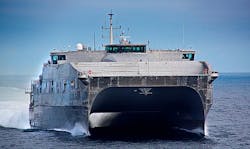Navy starts process of ordering eleventh expeditionary fast transport and ship electronics
WASHINGTON, 4 Nov. 2015. U.S. Navy leaders are getting ready to order the service's eleventh expeditionary fast transport (EPF) vessel and its ship electronics for the quick transport of warfighters, their equipment, and other cargo within battle theaters.
Officials of the Naval Sea Systems Command in Washington have announced a $53.5 million contract to Austal USA in Mobile, Ala., for long-lead-time material and initial engineering support for the Expeditionary Fast Transport (EPF) 11 (formerly Joint High Speed Vessel 11).
Long-lead items involve system components like electronics and propulsion that require the longest time to build, which could delay overall system production if money isn't allocated for production early in the process.
The Spearhead-class EPF will provide high speed, shallow draft transportation capability to support the intra-theater maneuver of personnel, supplies, and equipment for the Navy, Marine Corps, and Army. The vessel can reach speeds of 35 to 45 knots to move conventional or special forces warfighters, military equipment, and cargo.
The ship can transport company-sized units with their vehicles. As a troop transport it can move an infantry battalion. The EPF has a flight deck for helicopters and a load ramp to help drive vehicles on and off the ship.
This contract action is for the procurement of long-lead-time materials to support the detail design and construction of EPF 11. This action allows the procurement of ship sets for the specifications supporting integrated propulsion, main diesel generator engines, propeller and shafting, integrated bridge and voice communications.
This long-lead-item contract is to support detail design and construction of EPF 11, and enables Austal to acquire integrated propulsion, main diesel generator engines, propeller and shafting, integrated bridge equipment, and voice communications.
The EPF is an aluminum twin-hull catamaran with four diesel engines. Without resupply, it can support 312 embarked personnel for four days, or 104 personnel for 14 days. The design is 70 percent in common with the Hawaii Superferry, also built by Austal USA.
The control system for the EPF comes from General Dynamics Advanced Information Systems through an open-architecture computing infrastructure for combat and ship control systems that is similar to that of the Independence-class littoral combat ship (LCS), also built by Austal. The communications suite for this class comes from BAE Systems.
Navy leaders say they expect to buy 23 EPF vessels over 30 years. The first ship in the class, USNS Spearhead, was delivered in late 2012. Funding for the eleventh EPF was appropriated by Congress in the 2015 National Defense Authorization Act.
On this long-lead-item contract Austal will do the work in Novi, Mich.; Mobile, Ala.; Houston; Warminster, Pa.; Chesapeake, Va.; Gulfport, Miss.; Milwaukee; Slidell, La.; Iron Mountain, Mich.; Birmingham, Ala.; Pittsburgh; and locations, and should be finished by November 2019.
For more information contact Austal USA online at www.austal.com, or Naval Sea Systems Command at www.navsea.navy.mil.

